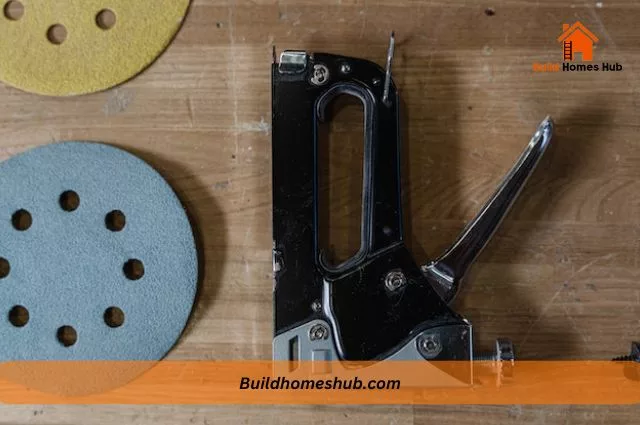Roofing is a crucial part of maintaining the integrity of any home or building. A leaky or damaged roof can lead to serious structural problems and costly repairs. While there are many ways to install a new roof, using a staple gun is a popular method that can save time and money.
This post will take a closer look at using staple guns for roofing, including the materials needed, safety precautions, and step-by-step instructions. We’ll also discuss common mistakes to avoid when using a staple gun for roofing and offer recommendations on when to use this method and when to hire a professional.
Can You Use Staple Guns to Put on a New Roof?
Yes, it is possible to use a staple gun to put on a new roof, but it is important to consider several factors before deciding if this method is appropriate for your project. One of the main factors to consider is the roofing material used.
Certain types of shingles, such as asphalt or wooden shingles, can be securely fastened with staples. In contrast, others, such as metal or synthetic shingles, may require a different installation method. The type and size of the staple gun being used can also affect the project’s outcome.
A high-powered industrial staple gun may be more appropriate for a larger and more complex roofing project, while a smaller and less powerful gun may be more appropriate for a smaller and simpler project.
Materials Needed for Roofing With a Staple Gun
List of necessary tools and materials:
1. Staple gun
A pneumatic or electric staple gun is recommended for roofing projects. Look for a model with a long nose and a depth adjustment feature.
2. Roofing underlayment
This waterproof barrier is installed between the roof deck and the shingles. It can be made of synthetic materials or felt paper.
3. Roofing shingles
The type of shingles you use will depend on the climate and your personal preferences. Options include asphalt, wood, metal, and composite.
4. Staples
The type of staples you use should be compatible with your staple gun and your chosen shingles.
5. Safety gear
This includes items such as a hard hat, safety goggles, work gloves, measuring tape, and a ladder
6. Roofing cement and sealant
These are used to seal any gaps or joints in the roofing materials.
Tips for selecting the right staple gun and roofing materials
- Consider the size and slope of your roof when choosing a staple gun. A pneumatic staple gun is best for larger roofs, and an electric one is best for smaller roofs.
- Look for a staple gun with an adjustable depth feature to ensure that the staples are driven to the appropriate depth.
- When choosing roofing shingles, consider the climate in your area. For example, a heavier shingle may be more suitable if you live in a region with high winds.
- Make sure the staples you choose are compatible with your selected shingles and your staple gun.
- Read the manufacturer’s instructions for the staple gun and the roofing materials before beginning the project to ensure proper use and installation.
Although staple guns can be used for some roofing projects, there are better solutions for some situations. Some roofing projects may require professional help, especially those that are complex or large. It’s essential to have a good understanding of roofing and the proper use of tools before starting a roofing project on your own.
Step-by-step Instructions for Roofing With a Staple Gun
How to properly install the underlayment
- Start by measuring the area of the roof that needs to be covered and purchasing the appropriate amount of underlayment.
- Lay the underlayment on the roof deck, making sure to overlap the edges by at least 2 inches.
- Use a utility knife to trim any excess underlayment.
- Staple the underlayment to the roof deck using a staple gun, making sure to place the staples every 6-8 inches along the edges and 12 inches in the field.
- Repeat the process until the entire roof is covered with underlayment.
Techniques for stapling the shingles to the roof
- Begin by installing a starter strip of shingles along the roof’s eaves, ensuring they are level and aligned with the roof’s edge.
- Use a chalk line to snap a line along the center of the roof to ensure that the shingles are properly aligned.
- Starting at the bottom of the roof, install the shingles by placing them on top of the underlayment and aligning them with the chalk line.
- Use a staple gun to secure the shingles to the roof, making sure to place the staples every 6-8 inches along the edges and 12 inches in the field.
- Repeat the process until the entire roof is covered with shingles.
Tips for ensuring a secure and professional-looking installation
- Make sure to use the appropriate number of staples for the type of roofing material you are using and the wind load in your area.
- Use a roofing hammer to ensure that the shingles are properly seated and to prevent any wind uplift.
- Use a roofing cement to seal any gaps or joints in the roofing system.
- Always wear the appropriate safety gear, such as a hard hat, safety glasses, and slip-resistant shoes.
- Inspect the roof after the installation is complete and address any issues that may have been missed.
Remember that staple gun is not recommended for high-wind areas. Always consult with professionals.
Common Mistakes to Avoid When Using a Staple Gun for Roofing
Common mistakes when using a staple gun for roofing include:
- Using the wrong size staples for the shingles or underlayment
- Overdriving the staples, which can cause damage to the shingles and compromise the integrity of the roof
- Not spacing the staples properly, which can lead to leaks and other issues
- Not properly aligning the shingles and staples can create an uneven and unsightly appearance
How to fix these mistakes
To troubleshoot and fix problems that may occur when using a staple gun for roofing, you can:
- Check the size of the staples being used to ensure they are appropriate for the shingles or underlayment
- Remove any staples that have been overdriven or spaced too closely together
- Realign any shingles that have been installed incorrectly
- Use roofing sealant to patch any leaks or other damage that may have occurred
- If you have any doubts or issues, it’s always best to consult a professional roofer.
Conclusion
Using a staple gun for roofing can be an effective and cost-efficient method for installing a new roof. However, it is important to keep in mind that there are some limitations and risks associated with this method. The key to success is careful planning, proper use of tools and materials, and adherence to safety precautions.
If you’re comfortable with DIY projects and have some basic handyman skills, you can handle a roofing project with a staple gun. However, if you need more clarification about your abilities or have doubts about your roof’s integrity, it is best to hire a professional.
I like to think I can help you with all the information you need on home renovations and DIY tips. You should subscribe.











